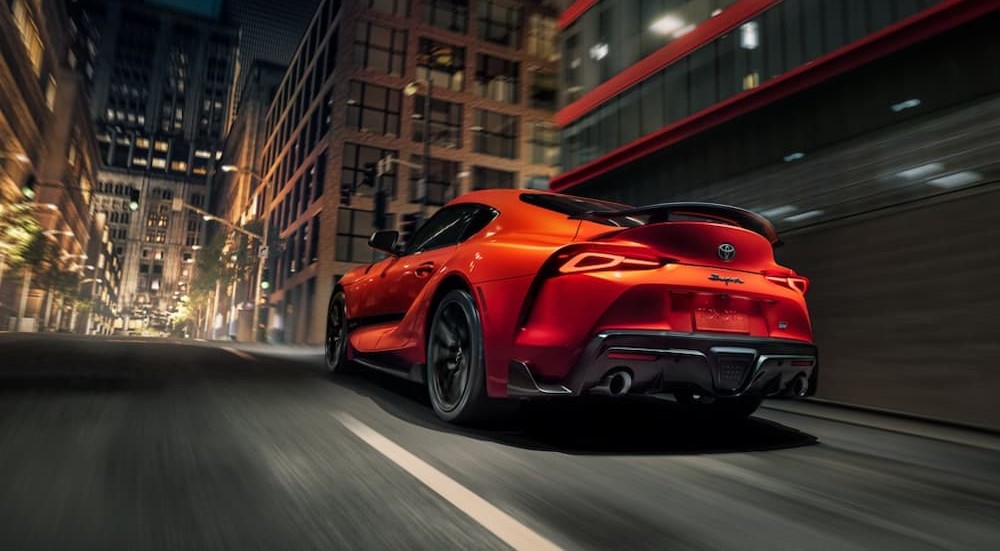Rumors of a track-focused Toyota Supra have been swirling since 2018 when chief engineer Tetsuya Tada casually floated the possibility in an interview. “I would like to see something like that eventually. We are preparing for it,” said Tada. This short quote set off years of anticipation among the Toyota faithful. This was reinforced in 2023 when Toyota first paired the Supra’s inline-six with a track-ready six-speed manual transmission. It looks like that patience will soon be rewarded in the form of the GRMN Supra.
Expected to debut in the first half of 2024, the range-topping 2025 GRMN Supra represents the pinnacle of Toyota performance. Some suspect the GRMN could also represent the Supra’s last hurrah as Toyota increasingly moves towards electrification. That’s not to say it’s the end of days for these types of high-performance Toyota models. There’s already word of an all-new, all-electric A100 model that could produce up to 500 horsepower. But goodbyes are never easy, and the GRMN variant will see the Supra go out in style. Join us as we see how the GRMN differs from the base Supra, decode its letter-heavy name, and see why this might be the most superlative Supra to date.
What’s in a Name?
The Supra carved out a reputation as one of the most iconic sports cars of the 1990s and early 2000s, even serving as the “hero car” for Paul Walker’s character in The Fast and The Furious. Despite its prominence, the Supra was put on ice in 2002 as Toyota struggled to meet tightening emissions standards. It was a major loss for fans of the renowned Japanese model, but Supra fans were rewarded for their patience as Toyota revived the Supra for its fifth generation in 2019.
Dubbed the Toyota GR Supra, the coupe’s name was tweaked to reflect the influence of the automaker’s Gazoo Racing (GR) division. While that sort of performance heritage certainly gave the fifth-generation Supra a leg up, the involvement of BMW really drew the industry’s attention. The GR Supra’s platform was developed in collaboration with the German automaker and shares a number of key design elements with the BMW Z4, including a short wheelbase, low center of gravity, and wide track. The GR Supra also boasts a BMW-designed 382-horsepower, 3.0L I-6 turbocharged engine and is built at the same Austrian factory as the Z4.
What does the forthcoming Supra GRMN add to the mix? Two letters, for a start. While the new moniker might remind some drivers of the AMC Gremlin, the Supra’s likely swan song couldn’t be any further from the short-lived subcompact. The model’s “MN” suffix is a nod to the late Toyota chief test driver and test engineer, Hiromu Naruse.
Over the course of his long, 47-year career with Toyota, Naruse logged more hours at Germany’s famed Nürburgring test track than any other Japanese driver. This accomplishment earned Naruse the nickname “Meister,” German for “Master,” and a reputation as the “man who knows all the world’s roads” in a bio penned by Ferrari. The GRMN pays homage to the storied test driver, with the latter half of the acronym recognizing Naruse as “the Meister of the Nürburgring (MN).”
Souped-Up Supra
The Supra is already a standout in the sports car segment, but it takes a little more to ensure consistent on-track success. Toyota has embraced the challenge, outfitting the GRMN Supra with various race-ready upgrades that should make the model the most thrilling yet.
It all starts under the hood, where the GRMN Supra is expected to borrow one of BMW’s most potent engines. Don’t get us wrong, the GR Supra’s existing engine is certainly nothing to turn your nose up at with a zero-to-60-mph time of 3.9 seconds, but the GRMN Supra will surely kick it up a notch. This was all but confirmed with the recent rumors of a forthcoming M variant of the BMW Z4, which would provide a solid roadmap for the Supra’s own upgrades.
All signs point to the GRMN Supra packing BMW’s 3.0L twin-turbocharged S58 engine. This is the same mill found in BMW’s high-performance M lineup, which is a promising start for the last-of-its-kind Supra. Currently found powering BMW’s X3 M, X4 M, M3, M3 Touring, and M4, the S58 can produce anywhere between 453 and 503 horsepower, depending on its tuning. The GRMN Supra would likely fall towards the lower end of that range as BMW attempts to avoid cutting into its own market share, given that a 500-horsepower Supra would likely siphon sales from the German brand’s high-performance M line.
The tuned, 543-horsepower version of the S58 engine that powers BMW’s M3 CS and M4 CSL is another powerplant possibility, though it might be a little bit of pie-in-the-sky thinking on our part, as that particular setup isn’t typically mated to a manual transmission. No matter which engine the GRMN Supra ships with, we expect the sports car will pack enough power to make the Meister of the Nürburgring proud.
On Track for Success
The BMW-sourced engine might be the star of the show when it comes to the forthcoming GRMN Supra, but it’s far from the only upgrade that will set the track-focused model apart from its fifth-generation GR Supra counterparts. Again, it’s a little early to speculate about specific performance upgrades, but some recent spy shots from the Nürburgring provide some clues. The most obvious enhancements can be found on the front end, where Toyota has outfitted the GRMN Supra with a number of components designed to improve the sports car’s aerodynamic profile. These include side splitters and a restyled front bumper with a set of canards that could go a long way towards improving the Supra’s longitudinal stability and control. The GRMN model also wears a large rear spoiler, creating the downforce that’s so critical in track applications. The spoiler is the spitting image of the one found on the 2024 Supra’s 45th Anniversary Edition, though the GRMN prototype looks to be fitted with its own unique tips and lightweight mounting brackets.
The GRMN Supra also looks to sit slightly lower than the base model, suggesting a revised suspension or a healthy amount of retuning to make it a bit stiffer. Traction-loving Michelin Pilot Sport Cup 2 tires are paired with lightweight wheels. We wouldn’t be surprised to see the GRMN Supra shipped with larger brakes and oversized calipers compared to the fifth-generation version. Cross-drilled rotors should reduce the overall weight while allowing the brakes to breathe and have the added benefit of helping to clean and refresh the brake pad surface.
The 2025 Toyota GRMN Supra will certainly be one for the history books, but not just because it’ll be the last model to wear the storied badge. Toyota’s GR division has long delivered some of the most exciting Toyota models to date, including race-ready versions of the Yaris, 86, and Corolla. The GR Supra has been a standout in its class since first hitting the market in 2019, but the GRMN takes that reputation one step further with a no-holds-barred performance package that would do the late Hiromu “Meister” Naruse proud. Toyota’s collaboration with BMW has already produced some eye-catching Supras over the years, and we’re excited to see what the sports car can manage when outfitted with one of the German brand’s most potent power plants. With a limited production run and an expected starting price of around $80,000, the 2025 GRMN Supra is as exclusive as it is intriguing, but that’s still a small price to pay to celebrate the Supra’s 45-plus-year run.




